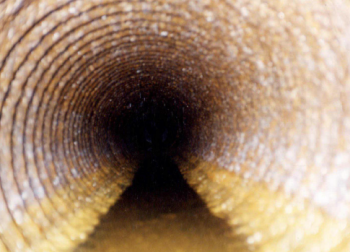O&M of Outlet Works

|
| Learn more about assessing the condition of an existing outlet conduit |
The necessity to perform controlled releases of stored water for water supply and regulation, recreation, flood risk management, irrigation, navigation, and environmental purposes via the outlet works makes its operation and maintenance one of the most important topics in dam safety. “Spillways and outlet works are necessary to provide capability to release an adequate rate of water from the reservoir to satisfy dam safety and water control regulation of the project”.[1]
Operation of Outlet Works
“Outlet works serve to regulate or release water impounded by a dam. It may release incoming flows at a reduced rate, as in the case of a detention dam; diver inflows into canals or pipelines, as in the case of a diversion dam; or release stored-water at such rates as may be dictated by downstream needs, evacuation considerations, or a combination of multiple-purpose requirements”.[1]
“Discharges from a reservoir outlet works fluctuate throughout the year depending upon downstream water needs and reservoir flood control requirements. Therefore, impounded water must be released at specific regulated rates. Operating gates and regulating valves are used to control and regulate the outlet works flow and are designed to operate in any position from closed to fully open. Guard or emergency gates are designed to close if the operating gates fail, or where dewatering is desired to inspect or repair the operating gates”.[1]
Maintenance of Outlet Works
“A pipe typically deteriorates as it ages, but proper maintenance, repair, and rehabilitation can extend its service life”.[2]
“Small, inaccessible conduits are especially vulnerable to plugging issues. Cleaning is usually only an issue where man-entry is not possible. If a conduit requires cleaning, it should only be done after careful consideration of the potential effects on known or suspected deterioration within the conduit. The basic philosophy used in the cleaning of conduits should be to ‘do no harm.’ This means a very cautious approach is required for cleaning of conduits”.[3]
“Cleaning may be required to improve the flow capacity within the conduit due to hard deposits, bacterial growths, sediments, or debris that may have collected in the conduit. Periodic operation of the conduit will flush out many of these types of collections. However, infrequent operation or nonoperation may allow for continued buildup of these collections”.[3]
“The improper use or the selection of incorrect cleaning equipment may cause additional damage to a deteriorating conduit and further degrade its structural integrity. The type of conduit material (i.e., concrete, plastic, or metal) must be considered in selecting the appropriate cleaning method. Some conduit materials (such as CMP) are much more prone to defects. Cleaning of inaccessible conduits should only be considered after CCTV thoroughly inspects the conduit. If a deteriorating conduit is cleaned without the benefit of CCTV inspection, the conduit may become unknowingly damaged”.[3]
“In some situations, minor cracks or joints experiencing seepage may eventually seal themselves by calcite deposition. This occurs when calcite precipitates out of solution and forms a deposit. Deposition may occur as the seepage evaporates, leaving the calcite behind. Calcite deposits typically mineralize and harden over time… If inspection shows locations within a conduit where this has occurred, cleaning with high pressure could remove enough of the calcite deposition to cause seepage to begin again. This possibility needs to be carefully considered prior to performing any cleaning operations within the conduit”.[3]
Examples
![]() Learn more about assessing the condition of existing outlet conduits
Learn more about assessing the condition of existing outlet conduits
Best Practices Resources
![]()
Trainings
![]()
Citations:
Revision ID: 3258
Revision Date: 09/15/2022
